Bernstein Symphonic Dances from West Side Story, Gershwin Second Rhapsody, An American in Paris, Rhapsody in Blue; Julian Jacobson, Mariko Brown; SOMM
Reviewed by Robert Hugill on 23 February 2022 Star rating: 4.0 (★★★★) on his website https://www.planethugill.com/2022/02/mm.html
Classic American pieces that cross over between jazz and classical come up delightfully sparkling in these transcriptions for two pianists
Transcribing music for two pianists (whether at one or two pianos) can often bring new insights, shorn of the brilliance and colour of the orchestration, the work’s bones are often seen better and can place the piece in new light. On this disc from SOMM, Manhattan to Montmartre, pianists Julian Jacobson and Mariko Brown perform duet transcriptions of four iconic works, Leonard Bernstein’s Symphonic Dances from West Side Story, and three works by George Gershwin, Second Rhapsody, An American in Paris and Rhapsody in Blue. The Bernstein was transcribed for two pianos by American composer John Musto in 1998. Gershwin’s Second Rhapsody, and An American in Paris were transcribed for piano duet by Julian Jacobson in 2014 and 2016 respectively, whilst Rhapsody in Blue was transcribed for piano duet by Henry Levine in 1925, a version that Gershwin used to play with friends.
In 1910, more than three-quarters of the population of New York were either immigrants or the children of immigrants, so no wonder the city’s musical culture developed as such a melting pot, combining music from European homelands with African American music and more. Irving Berlin was born in Russia, Vernon Duke was originally Vladimir Dukelsky, George Gershwin was the son of immigrants from Russia, Richard Rodger’s grandparents were Russian immigrants whilst Leonard Bernstein’s parents were from the Ukraine [I am indebted to Robert Matthew-Walker’s admirable booklet note for this fascinating information]. Additional to this Russian factor should be added that many (if not all) these immigrants were of Jewish origins, the Russian pogroms against the Jews in the late-19th and early 20th centuries causing significant problems.
The sense of musical hybridisation, the creation of new strains by combining existing ones, was palpable and of course, it continued on a multiple levels. So that George Gershwin, having mastered Tin Pan Alley and the Broadway via a genre that modern research suggests owes rather a lot of Klezmer, moved to reabsorb the 20th century classical idiom. With transcriptions for piano, we no longer have to worry about whether we should be listening to Gershwin’s Rhapsody in Blue in its original jazz-band orchestration by Ferde Grofé or in the later symphonic version. The Second Rhapsody and An American in Paris would be premiered in Gershwin’s own orchestrations and there is evidence to suggest that he was intending to do his own orchestral version of Rhapsody in Blue.
The disc begins, however with Bernstein, his symphonic suite based on the music from the musical. West Side Story debuted in 1957 and Bernstein created the Symphonic Dances for the New York Philharmonic, which premiered the work in 1961. This is far more then simple greatest hits, it is a 20 minute sequence that effectively tells the story in music, with writing for orchestra that is more complex than Bernstein might consider for a stage musical.
Besides having individual solo careers, Julian Jacobson and Mariko Brown have been playing as a piano duo since 2011 and it shows. The bring a sense of unanimity of purpose and clarity to this music. There is a lovely rhythmic snap to their Bernstein, along with a sense of relishing the complex textures and the drama. There is plenty of lyric beauty here, but what we constantly notice is Bernstein’s relishing of complexity of texture, rarely are there melodies with a simple oom-pah rhythm accompaniment. We have come a long way from Tin Pan Alley of the early 20th century. And of course, the short finale is devastating and far from a traditional musical.
Gershwin regarded his Second Rhapsody as the finest thing he had written, but it rarely gets proper attention. It lacks the dazzle of the earlier rhapsody and perhaps the panache. You don’t quite come out humming the tunes, but as a musical work it is more sophisticated and stronger than the earlier music. This strength comes out in Jacobson’s transcription, without the brilliance and colours of the orchestra (though the two pianists demonstrate their own wide range of colours) we get a sense of the work’s complex textures and remarkably mid-century musical style. Jacobson and Brown make the rhapsody seem less jazzy, and more akin to the music in Europe that Gershwin was listening to – Stravinsky, Ravel and perhaps even Bartok.
Whilst Gershwin’s An American in Paris was all his own work (after Rhapsody in Blue, he did the orchestrations of his Concerto in F and American in Paris himself), Gershwin still composed at the piano and it is this factor that probably lends the work to transcription. Gershwin wasn’t alone in this, Stravinsky’s own piano four-hands versions of his early ballets have developed come currency and these were not arrangements but initial versions. Again the rhythmic alertness of the playing delights, along with the way the two players mesh together so that fragments emerge from the textures and disappear, reflecting the colours of the original orchestra. This is a performance that puts a real smile on the face.
Finally we reach Rhapsody in Blue. Full of rhythmic verve and a remarkable range of colours, there is a nice swing to the music yet it clearly is not jazz. The transcription brings out the Rhapsody’s remarkable bones, and both Jacobson and Brown have the time of their lives with the music, managing to be fun and complex.
Leonard Bernstein (1918-1990), transc. John Musto, 1998 – Symphonic Dances from West Side Story [21:52]
George Gershwin (1898-1937), transc. Julian Jacobson, 2014 – Second Rhapsody [15:03]
George Gershwin, transc. Julian Jacobson, 2016 – An American in Paris
George Gershwin, transc. Henry Levine, 1925 – Rhapsody in Blue
Julian Jacobson (piano)
Mariko Brown (piano)
SOMM SOMMCD 0635 1CD [72.30]
Buy the CD here: https://www.somm-recordings.com/recording/manhattan-to-montmartre/
Listen below on Spotify:
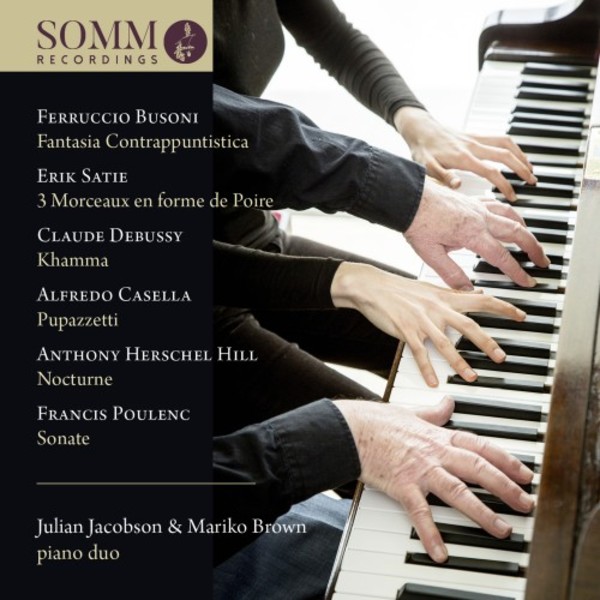
New CD – available now.
BUSONI / ANTHONY HERSHEL HILL / SATIE / DEBUSSY / CASELLA / POULENC
Julian Jacobson & Mariko Brown Piano Duo. Somm £10.00
Catalogue Number:SOMMCD0178
Humphrey Searle was another devotee of Liszt, not the obvious enthusiasm for one of the first
British 12-note composers. His Sonata was written for Liszt’s 140th birthday in 1951 and premiered
on that day by Gordon Watson, who made the first recording. Julian Jacobson puts this taxing but
impressively rhetorical piece through its paces brilliantly – just the kind of gesture Smith would
have admired, bringing something unknown to a wider audience.
 Martinu: Sinfonietta Giocosa, Toccata e Due Canzone and Sinfonia “La Jolla”
Martinu: Sinfonietta Giocosa, Toccata e Due Canzone and Sinfonia “La Jolla”Chandos CHAN 8859
With the Bournemouth Sinfonietta, conducted by Tamas Vasary.
“Julian Jacobson, in stylish and idiomatic fashion, delivered the important concertante piano part with immense brio; the orchestra complementing his efforts in a brilliantly successful account”.
(Sinfonietta Giocosa) –The Guardian
“First rate performances” –David Hurwitz
Buy on iTunes
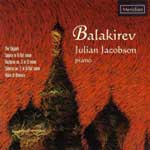 Balakirev – Julian Jacobson – Piano
Balakirev – Julian Jacobson – PianoMeridian CDE 84453
“English pianist Julian Jacobson is certainly a virtuoso; not so much as a finger slip in all of the digital gymnastics can be heard in the course of Meridian’s Balakirev Piano Music” –All Music Guide
Buy on iTunes
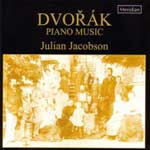 Dvorak: Piano Music
Dvorak: Piano MusicMeridian CDE 84521
“Well played and recorded” –Fanfare
“Amazon description’s (of) Julian Jacobson is complete and describes very well this great interpreter. He’s one of Britain’s most creative and distinctive pianists… this really interesting and original recording proves it”
Buy on iTunes
 Weber: Piano Sonatas, Vol. 1
Weber: Piano Sonatas, Vol. 1Meridian CDE 84251
“This is played in an exciting and commited manner with lots of dash and elan… Jacobson plays the ‘invitation to the dance’ with tremendous sensitivity and care” –CD Review
Buy on iTunes
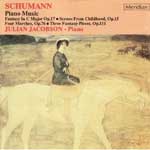 Schumann: Piano Music
Schumann: Piano MusicMeridian CDE 84205
Fantasy in C Major Op 17. Scenes from Childhood, Op 15. Four Marches Op 76. Three Fantasy Pieces, Op 111.
Buy on iTunes
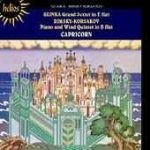 Glinka Grand Sextet and Rimsky Korsakov Quintet for Piano and Winds with Capricorn
Glinka Grand Sextet and Rimsky Korsakov Quintet for Piano and Winds with CapricornHyperion A 66163
“Brilliantly nimble and felicitous… he contributes a rare sparkle to the proceedings” –Penguin Guide to Compact Discs
Buy on iTunes
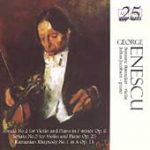 Enescu: Violin Sonatas No. 2 & 3 and Romanian Rhapsody No. 1
Enescu: Violin Sonatas No. 2 & 3 and Romanian Rhapsody No. 1CDE 84469
“Stanzeleit and Jacobson… bring a spirited eloquence to these performances, revelling in the sonatas’ virtuoso demands as well as their atmospheric lyricism, and they’re recorded in a pleasantly natural ambience” –Calum MacDonald, BBC Music Magazine
Buy on iTunes
 English Violin Sonatas
English Violin SonatasCACD 88036
“All praise then to Julian Jacobson whose intelligent and spirited playing make him one of the best two or three pianists who have consistently dedicated themselves to British contemporary music” –Tempo
Buy on iTunes
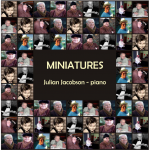 Miniatures
Miniatures
Programme of “Miniatures” CD
1. Mozart Rondo in D
2. Schubert Impromptu in G flat
3. Granados “The Maiden and the Nightingale”
4. Maurice Jacobson Sarabande
5. Robert Schumann “Warum?” (“Why?”)
6. Debussy Two Preludes
La Puerta del Vino
Bruyères
7. Liszt Valse oubliée no.1
8. Brahms Intermezzo op 116 no 4
9. Grieg “Butterfly”
10. Ravel Minuet from “Le Tombeau de Couperin”
11. Scriabin Album leaf op 45 no.1
12. Scriabin Prelude op 16 no.1
13. Debussy Clair de Lune
14. Rachmaninov Prelude op 23 no.4
15. Rachmaninov Etude-Tableau op 33 no.7
16. Chopin Barcarolle
This CD cab be ordered from this website. Simply send Julian a message.
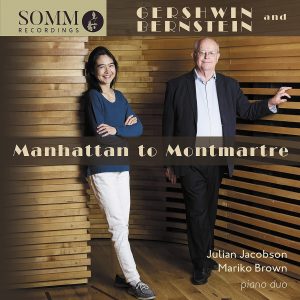
 Weber: Piano Sonatas, Vol. 2
Weber: Piano Sonatas, Vol. 2